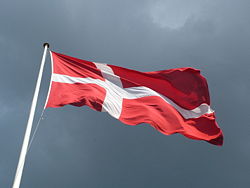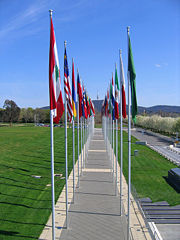Flags & Flagpoles
A flag is a piece of cloth, often flown from a pole or mast, generally used symbolically for signaling or identification. The term flag is also used to refer to the graphic design employed by a flag, or to its depiction in another medium. more...
The first flags were used to assist military coordination on battlefields and flags have evolved into a general tool for rudimentary signaling and identification, This was especially used in environments where communication is similarly challenging (such as the maritime environment where semaphore is used). National flags are potent patriotic symbols with varied wide-ranging interpretations, often including strong military associations due to their original and ongoing military uses. Flags are used in messaging, advertising, or for other decorative purposes. The study of flags is known as vexillology, from the Latin vexillum meaning flag or banner.
History
According to the Encyclopedia Britannica: "Flags recognizable as such were the invention, almost certainly, of the ancient Indians or the Chinese." The usage of flags spread from India and China to neighboring Burma, Siam, and southeastern Asia.
Originally, the standards of the Roman legions were not flags, but symbols like the eagle of Augustus Caesar's Xth legion; this eagle would be placed on a staff for the standard-bearer to hold up during battle. But a military unit from Dacia had for a standard a dragon with a flexible tail which would move in the wind; the legions copied this; eventually all the legions had flexible standards — our modern-day flag.
During the Middle Ages, flags were used mainly during battles to identify individual leaders: in Europe the knights, in Japan the samurai, and in China the generals under the imperial army.
From the time of Christopher Columbus onwards, it has been customary (and later a legal requirement) for ships to carry flags designating their nationality; these flags eventually evolved into the national flags and maritime flags of today. Flags also became the preferred means of communications at sea, resulting in various systems of flag signals; see International maritime signal flags.
As European knights were replaced by centralized armies, flags became the means to identify not just nationalities but also individual military units. Flags became objects to be captured or defended. Eventually these flags posed too much danger to those carrying them, and by World War I these were withdrawn from the battlefields, and have since been used only at ceremonial occasions.
National flags
-
One of the most popular uses of a flag is to symbolize a nation or country. Some national flags have been particularly inspirational to other nations, countries, or subnational entities in the design of their own flags. Some prominent examples include:
Read more at Wikipedia.org





